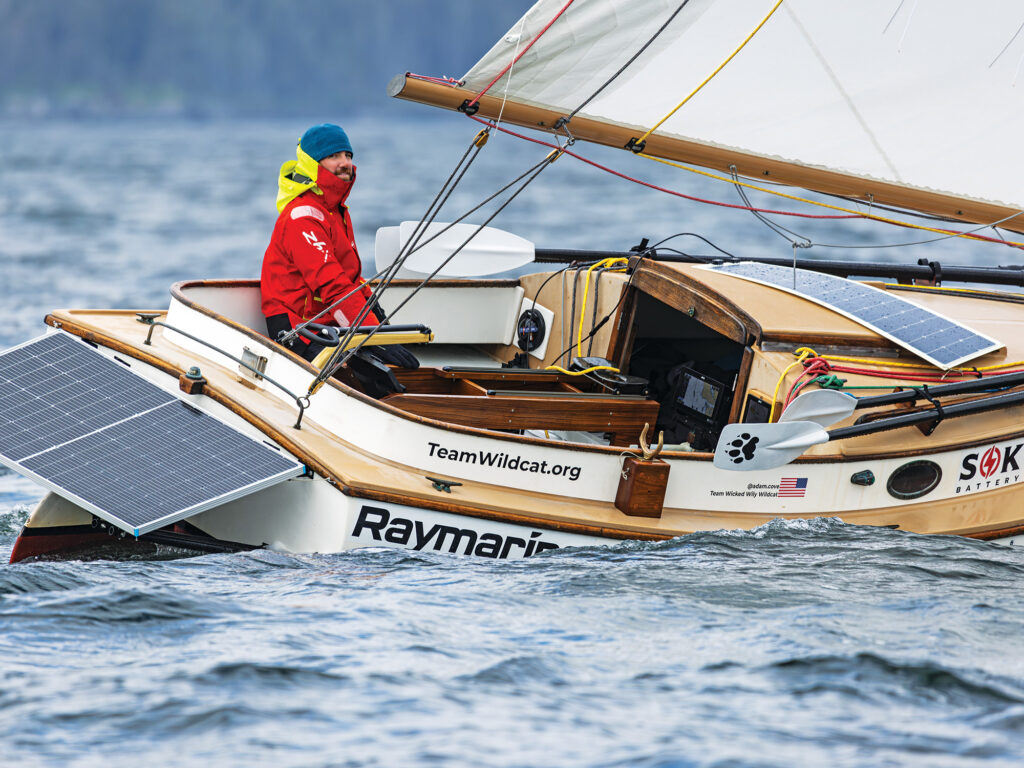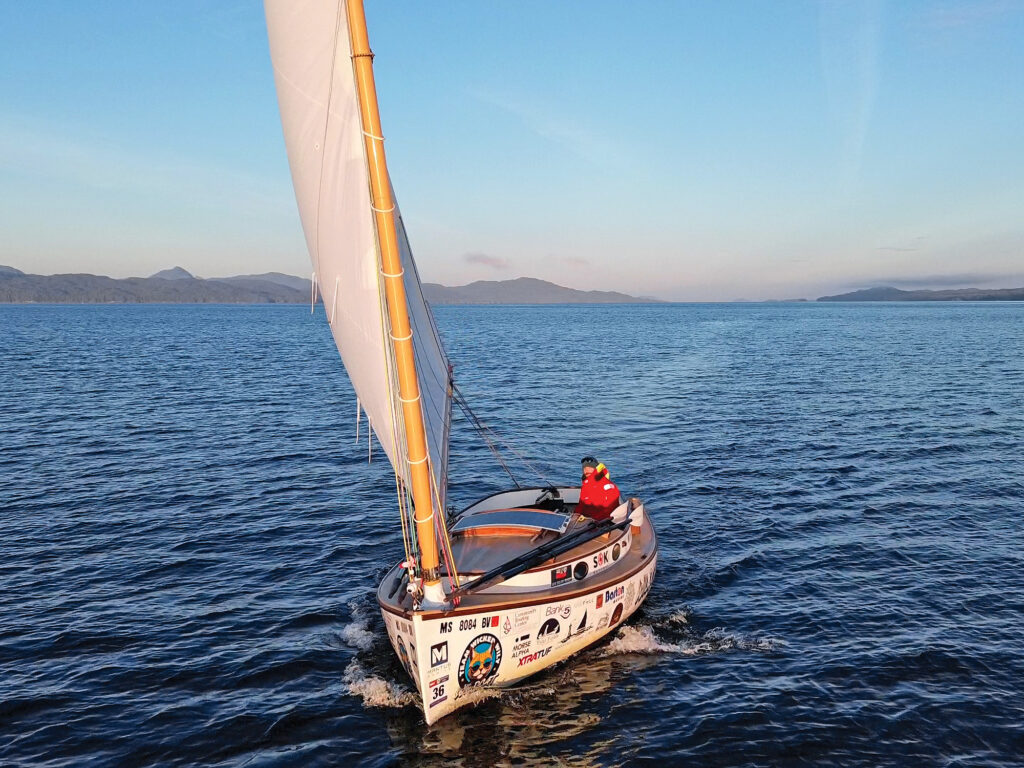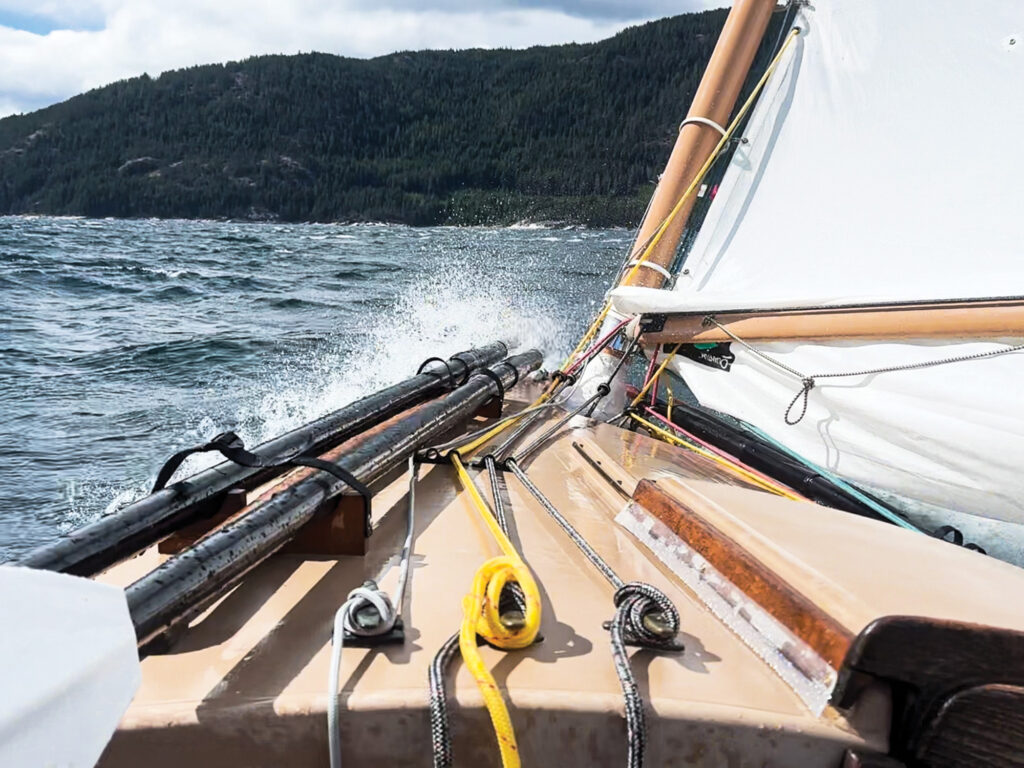SB Television
How A Small Catboat Won Its Biggest Adventure Race
 Race to Alaska soloist Adam Cove progresses up the 750-mile course on his Marshall Sanderling catboat.
Taylor Bayly
Race to Alaska soloist Adam Cove progresses up the 750-mile course on his Marshall Sanderling catboat.
Taylor Bayly
As the white blades of his sculling oars dipped and swept the pristine waters of the Strait of Georgia, Adam Cove was having fleeting second thoughts. He was barely a day into the adventure—no-engine-and-no-support 750-mile Race to Alaska. His plan to row his 2,800-pound 18-foot Marshall Sanderling cat boat Wildcat through a set of islands and farther offshore in search of wind had backfired.
.embed-container { position: relative; padding-bottom: 56.25%; height: 0; overflow: hidden; max-width: 100%; } .embed-container iframe, .embed-container object, .embed-container embed { position: absolute; top: 0; left: 0; width: 100%; height: 100%; }“The wind was forecast to be there,” he says. “I got out there after rowing for six hours because the wind had died inside, but there was no wind out there either. And then the current turned and I was 3 miles out, so I just started rowing harder to get close to the coast. That was a brutal 8 hours straight of rowing, and by the time I reached anchorage, I said, ‘I still have another 660 miles to go—this is going to be a long race.’”
This was an R2AK baptism by agony for Cove on his first attempt at the biennial race, but he was prepared for it. There would be no quitting.
The Race to Alaska’s course winds mostly along the rugged Canadian coastline, with a start in Port Townsend, Washington, and a finish in Ketchikan, Alaska. There is a 40-mile qualifying leg from Port Townsend to Victoria, British Columbia, which essentially thins the herd, and Cove aced that section. What follows, however, is the far more testing 710-mile stretch to Ketchikan, which takes the fleet first through Seymour Narrows, revered for its swift currents and capricious winds. Then there’s a long open stretch across Queen Charlotte Sound with a mandatory checkpoint in a town called Bella Bella in British Columbia. From Bella, it’s into the open waters of the Hecate Strait, dodging logs, debris and wildlife. How, where, and when competitors stop to rest, replenish, or escape adversity is entirely up to them.
The eclectic fleet of vessels that now gathers every other year is not all sailboats or necessarily oceangoing, and the adventurers themselves are equally unique. Cove generalizes his fellow competitors as “very hyped-up, athletic, excited and a cool crowd.” He fit in well among them.
The Lemans start from Victoria on June 12 sent Cove on his way, meandering through islands, rowing until the reaches of Seymour Narrows, the race’s first true proving point. “This is the area that everyone talks about,” he says. “You don’t sail through at night; you don’t sail through with the full current. You wait for the slack tide.”
However, by the time he approached Seymour at 3 a.m., he had the full embrace of the current to carry him through. “I hit 12 knots over ground, with 4 knots of wind, which might be a record for a cat boat,” he says. “But it was wild. There were whirlpools everywhere, and the boat made three complete 360s going through there.”
 Cove’s meticulous preparation ensured his arrival at the finish without any breakages, and in record time.
Adam Cove
Cove’s meticulous preparation ensured his arrival at the finish without any breakages, and in record time.
Adam Cove
Now roughly two and a half days into the race, Cove and his Wildcat had devoured a good bit of the course, and only once he was flushed through the Narrows was he able to make his first respite.
“I rode the current until it pretty much stopped, then pulled over and slept for about four and a half hours,” he says. “I woke up in a beautiful little cove, and when the current switched, I jumped back out there again and continued racing.”
Ahead, he says, was the most treacherous part of the course—Johnstone Strait, a half-mile-wide sluice with high mountains and roaring winds that funnel through the straight one way or the other. For Cove, it was all uphill.
“I had 26 hours of short-tacking between the shorelines,” he says. “You try to fight the current as long as you can, but eventually it wins. The real challenge is there’s not a lot of places to pull over.”
He did eventually sniff out a place to shelter—a shallow spot behind a pile of rocks—dropped anchor, and hoped for the best. “I was so tired, but I went for it,” he says. “The best part was, when I woke up in the morning, the current had switched, so all I had to do was pull up the anchor. I already had my centerboard up, being a cat boat, so I just drifted over the rocks and kept going—another cat boat advantage I hadn’t considered.”
Cove’s choice of a Marshall 18 cat boat for the race was a suggestion from his wife, and a family connection at Marshall Cat Company boatyard in South Dartmouth, Massachusetts, was just the source he needed to line up the adventure. Over one long New England winter, he set about preparing the boat with the help of family and industry contacts, stripping 120 pounds of old bottom paint, renewing the brightwork, replacing portlights and rudder hardware, blocks and lines, adding a third-reef into the sail, and installing a sophisticated Raymarine electronics package. The biggest project was custom building a rowing station with a sliding seat, which proved to be time well spent.
After pinballing through Johnstone Strait, Cove presumed that the worst of the course was behind and that it would be smooth sailing to Ketchikan. But he was wrong.
“I got to the other side saying, ‘I’m ready to be out of here,’ but then I was right into 6- to 7-foot breaking waves. Every single wave, I was taking on water. I’d hit the wall.”
When racing solo, misery’s company is oneself, but Cove was relishing the torment. It was exactly what he’d signed up for. “I’ve done a fair amount of offshore racing, and everyone always builds the offshore side to be that much harder,” he says. “In coastal racing like this, especially if you’re singlehanded, there are so many more things to hit. This was something I had pushed myself to do. And I was up for that challenge.”
He did tuck his third reef twice, to what amounted to a small triangle of sail, which he says was a big consideration when preparing for the race. “Figuring out that balance and how to compensate for the large rudder and the weather helm. We found it made a big difference putting a lot of forward rake on the mast. That moves the center of effort forward on the sail quite a bit. So up to 10 knots, it’s actually a balanced helm, which is crazy that we could achieve that on a cat boat.”
 Wildcat heading upwind.
Adam Cove
Wildcat heading upwind.
Adam Cove
His Starlink terminal proved to be an essential piece of equipment for sending media for the boat, but also for relaying conditions and information to his fellow competitors scattered about. “Everyone supports one another through the race,” he says. “You want everyone to be successful and to keep sailing because there really are limited rescue resources up there. The Coast Guard is close, but when you consider the water temperatures, by the time they get to you, you’re likely dead.”
Cove predicted that he would do the race in two weeks or so, and had plenty of freeze-dried food and supplies to get him to Ketchikan—in hindsight, he was way overprovisioned. And as much as he was racing to win, the reason why he chose a cat boat over a quicker vessel like a trimaran or sportboat was to allow him more time in the elements, to savor the journey that much more.
“The biggest highlight of the race is just being able to appreciate the scenery around us and overcoming the challenge,” he says. “It’s just absolutely gorgeous throughout the entire course. It’s tough to beat anything on that level.”
“I got to the other side saying, ‘I’m ready to be out of here,’ but then I was right into 6- to 7-foot breaking waves. Every single wave, I was taking on water. I’d hit the wall.”
He had three goals when he set out from Port Townsend: to finish the race, to be the first singlehanded boat to finish, and to finish inside of 14 days. “I realized kind of through the course rather quickly that I was exceeding all of those goals,” he says.
But then came the final miles, which felt much like the first.
Ten miles from the finish, the once-30-knot wind that was scooting him to Ketchikan faded to zephyrs, and then the current turned hard against him. “I felt like the finish might as well be 100 miles away, so I rowed as hard as I could to port. I was about 15 feet away from shore and caught a back current, and rode that for about 5 miles until I got to the last channel turning into Ketchikan. The current was against me again, and I just powered through it. It was super frustrating, and it just turned into pure determination. I was like: ‘I gotta finish this race. I’m so close right now.”
When Cove stepped ashore to ring the symbolic finish bell, as per tradition, he was well inside his 14-day target at 10 days, 22 hours, 26 minutes. Better yet, he had broken the singlehanded monohull record by more than two days and was the race’s fastest monohull ever, under 20 feet. A true vindication of his craft of choice. “It ended up being the perfect boat,” he says. “I had all the shelter I needed, and I was shocked at how fast that boat was. There was one night, going downwind with the centerboard up, where I was surfing waves and doing between 8 knots and 9.2 knots for hours on end.”
While it would seem logical for Cove, a marine consultant and technical editor for SAIL, based in Massachusetts, to write some definitive guide to preparing for and winning the race, you can count on that never happening. “A few of us casually talked about that with the race organizers,” he says. “And they said that it’s probably best that we don’t do that because it’s fun for everyone to learn on their own. It’s the sharing among each other that builds the community. Don’t make it too easy to get—make them come to you and talk, because that’s a big part of it, becoming part of the R2AK family.”
The post How A Small Catboat Won Its Biggest Adventure Race appeared first on Sailing World.
- Home
- About Us
- Write For Us / Submit Content
- Advertising And Affiliates
- Feeds And Syndication
- Contact Us
- Login
- Privacy
All Rights Reserved. Copyright , Central Coast Communications, Inc.